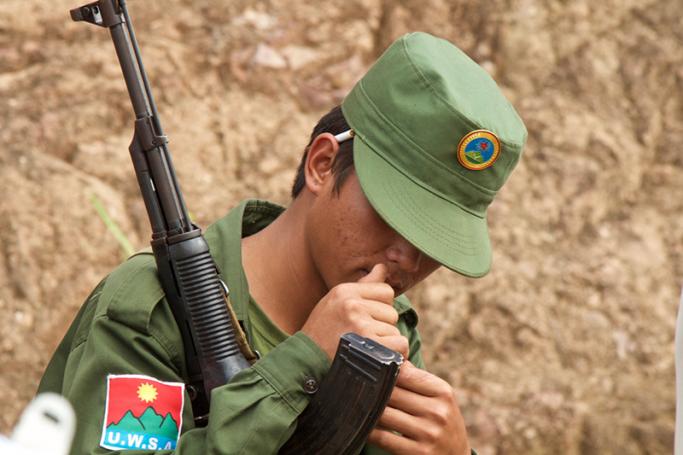Last week Myanmar media and Facebook were ablaze with reports of clashes between the United Wa State Army (UWSA) and National Democratic Alliance Army (NDAA), aka the Mong La group.
The photos and video that were passed around on social media, showed what appeared to be NDAA soldiers surrendering to UWSA. Causing many to wonder why the longtime allies would be fighting.
Both the UWSA and NDAA were formed in the aftermath of the 1989 mutiny that brought an end to the Communist Party of Burma. They have had an ironclad relationship since the days of the CPB along with the Myanmar Democratic National Alliance Army aka the Kokang.
Wa Sate media right away tried to put an end to the rumours by simply stating that the photos and video that appeared online were an overreaction by a Wa leader who was angered by the way his car was rudely inspected while going through a checkpoint. The leader then called in his forces to catch those who were responsible for disrespecting him. Wa media went on to say that both the UWSA and NDAA are working to solve the matter and people should not listen to the rumours.
However, Myanmar media had a field day with the incident and reported that the clashes were in retaliation to the NDAA’s decision to send a higher-ranking delegation, led the NDAA leader Sai Luen, to attend the 21st Century Panglong Conference, in Naypyidaw. Thus one-upping the UWSA delegation that was headed by lower ranking Wa officials. However, these accusations have yet to be verified by either the UWSA or the NDAA.
But it seems Myanmar media cannot back their claims that the NDAA leader Sai Luen did, in fact, attend the 21st Century Panglong Conference because there are no photos of Sai Luen attending the conference.
The Shan Harald followed up an earlier report stating that UWSA sent in around 600 troops from UWSA’s Battalion 468, and seized three NDAA bases: “two mountain bases, Loi Kiusai and Loi Hsarm Hsoom, and a checkpoint at Parng Mark Fai,”
According to Shan Harald Pao Aik Pang, the commander of UWSA Battalion 468, had informed NDAA officials that the two mountain outposts would not be returned to them”
Meanwhile, Wa State media reported that the UWSA will start a three-month long artillery training program involving some 400 cadets.
The UWSA is known to have Chinese type 96 122mm howitzers and is the only Ethnic Armed Organization to have heavy artillery that can match the firepower of the Myanmar Army.
During this three-month training program that is set to kick off at the start of the dry season, we are likely to see reports of Chinese Peoples Liberations Army advisers leading the training exercise because of the complexity of the weapon.
The type 96 122mm howitzer is produced by China North Industries Corporation (NORINCO) and is a copy of the Russian D-30 howitzer and fire a 21.76kg projectile, with a range of 15,300m to 18,000m or between 9 to 11 miles. Along with the standard projectile the type 96 can also fire a wide range of ordnance that is designed to attack surface targets and armoured vehicles.
If the UWSA really did take those two bases, there can only be two reasons why the Wa would take over the two strategic mountain positions, of Loi Kiusai and Loi Hsarm Hsoom that overlook Kengtung Township. The first would be that the Wa are preparing for the worst in case peace talks do not go well and the Myanmar army decides to advance on their territory. If so, the UWSA could move their type 96 122mm howitzers and defend the high ground in case the Myanmar military tries to take Mong La.
The second reason could be out of paranoia over recent plans by the US to rekindle military to military engagement with Myanmar. Either way, the Wa are preparing for a fight.
The U.S. and Myanmar once had a history of cooperation since Myanmar independence in 1948. In the 1980’s U.S. arms sales reached 4.7 million dollars annually and 167 Myanmar soldiers attended U.S. military schools under the International Military Education and Training (IMET) security assistance program. But this all came to an end after the military crackdown in 1988.
It will be interesting to see what happens next, the United Wa State Army is in the process of opening up after years of self-imposed isolation from the rest of Myanmar. They have recently taken part in Aung San Suu Kyi’s efforts to bring peace and national reconciliation but walked out of her conference over inequality and discrimination. The Wa have also taken unprecedented steps to reached out to the foreign press in order to whitewash their image.
But the announcement of a three-month long artillery training exercise, which might involve PLA advisers, shows that the Wa still does not trust Naypyidaw and reminds us of an old Chinese proverb that goes “Rivers and mountains are easy to change, man’s character is much harder”
You are viewing the old site.
Please update your bookmark to https://eng.mizzima.com.
Mizzima Weekly Magazine Issue...
14 December 2023
Spring Revolution Daily News f...
13 December 2023
New UK Burma sanctions welcome...
13 December 2023
Spring Revolution Daily News f...
12 December 2023
Spring Revolution Daily News f...
11 December 2023
Spring Revolution Daily News f...
08 December 2023
Spring Revolution Daily News f...
07 December 2023
Diaspora journalists increasin...
07 December 2023
More than 70,000 IDPs return home after fighting stops in Rakhine












